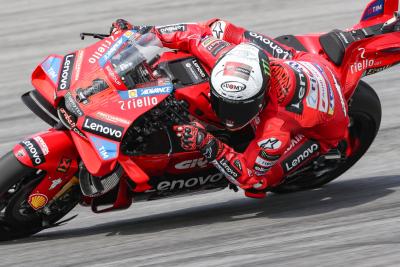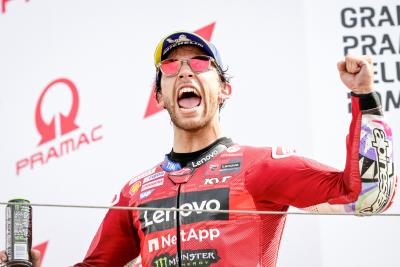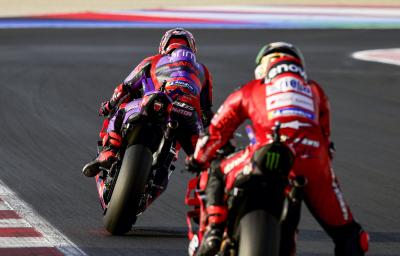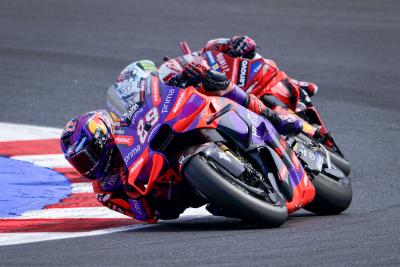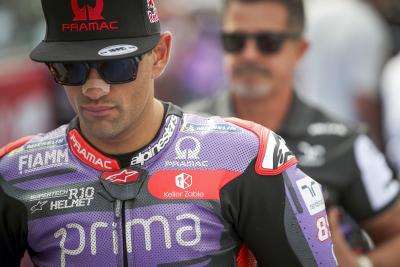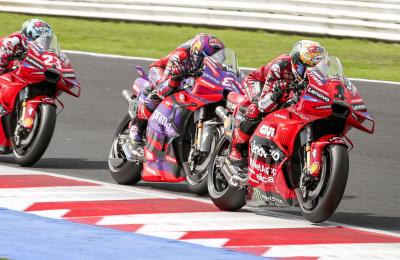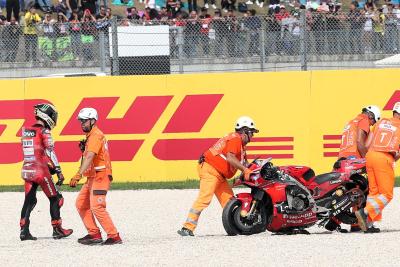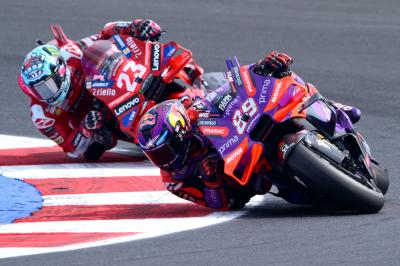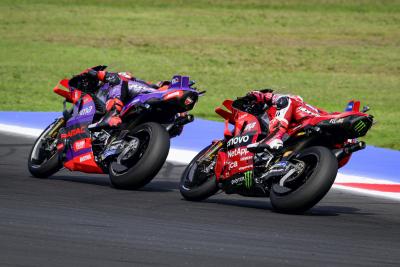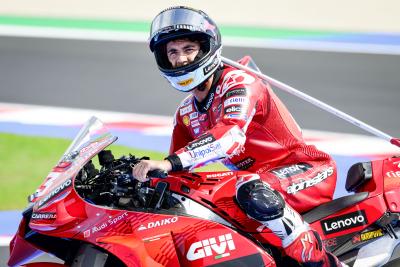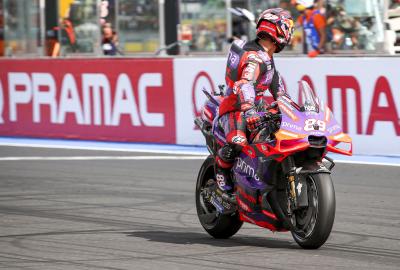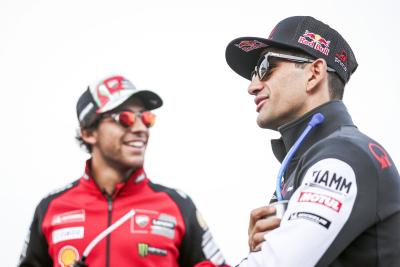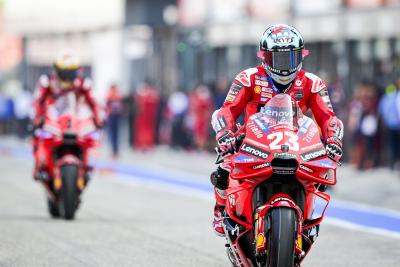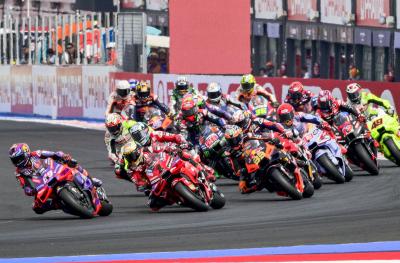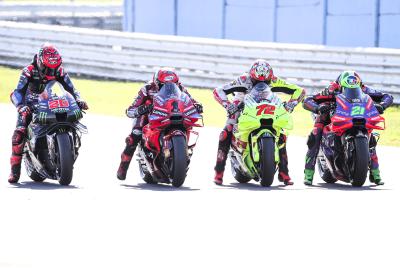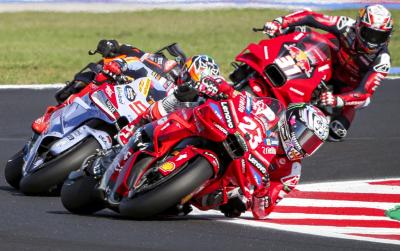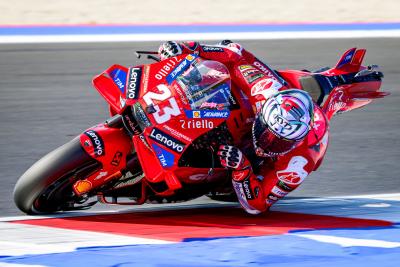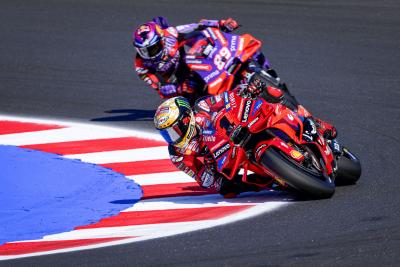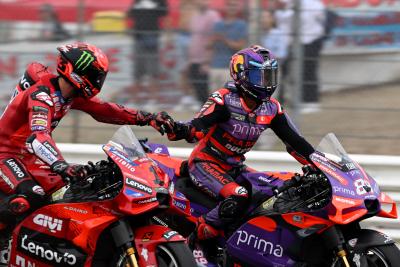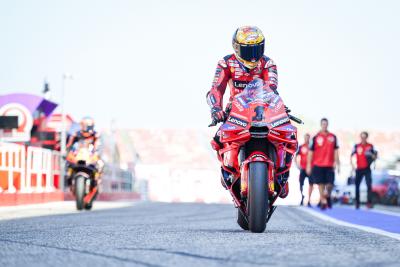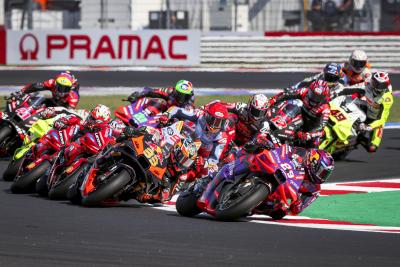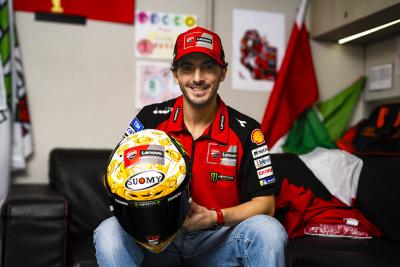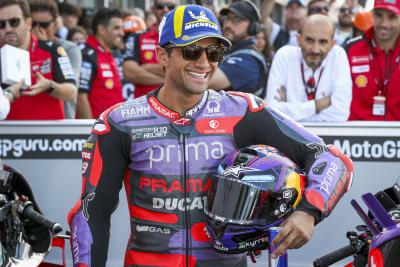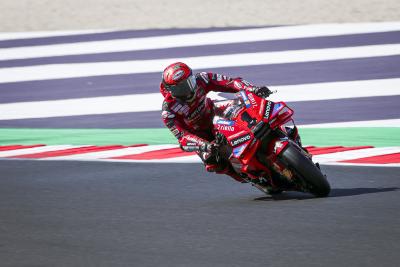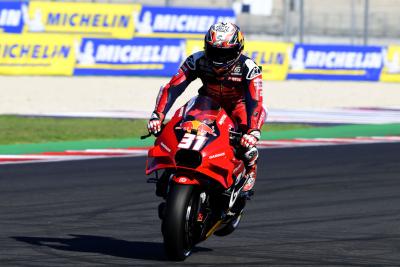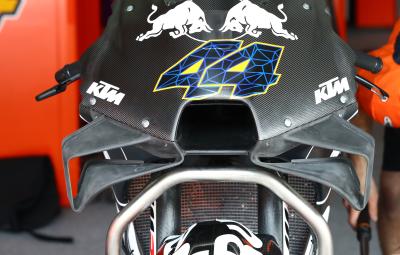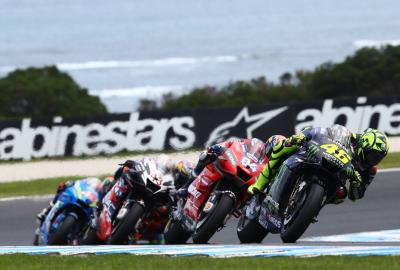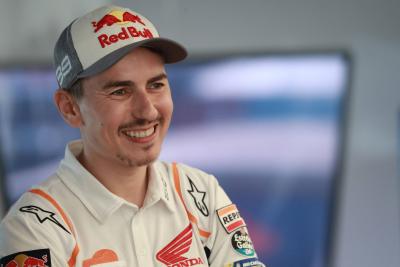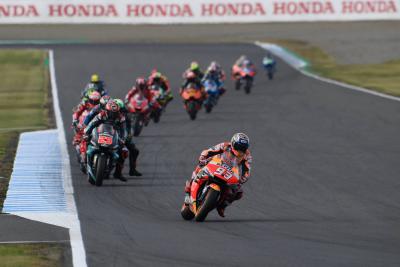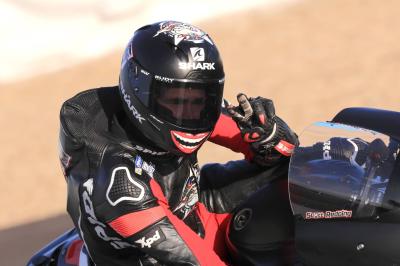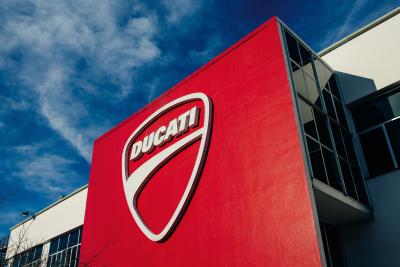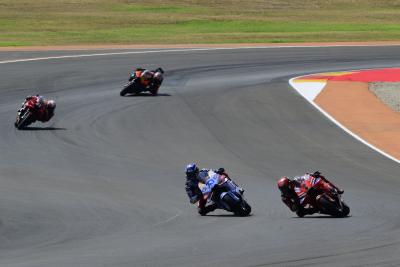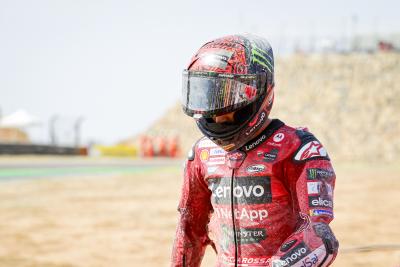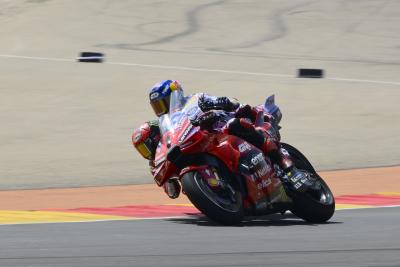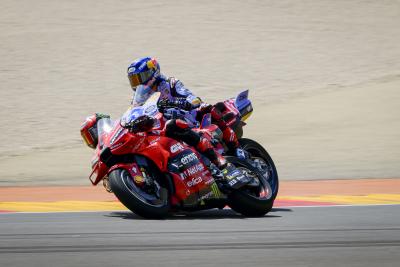Ducati Lenovo Team
Team Statistics

About Ducati Lenovo Team
Ducati in 2024
Ducati Lenovo starts the 2024 MotoGP season with reigning double champion Francesco Bagnaia looking to join only Valentino Rossi and Marc Marquez in winning three successive titles during the modern four-stroke era (since 2002).
Latest News
Team Information
Ducati in 2024
Ducati Lenovo starts the 2024 MotoGP season with reigning double champion Francesco Bagnaia looking to join only Valentino Rossi and Marc Marquez in winning three successive titles during the modern four-stroke era (since 2002).
Enea Bastianini remains alongside Bagnaia for a second term, the four-time 2022 race winner for Gresini looking to bounce back from a miserable injury-interrupted debut year in factory colours where a shock Sepang victory was the only highlight.
Ducati's MotoGP history
Renowned for its racing exploits in Superbike, the change in premier-class technical rules from 500cc two-strokes to 990cc four-strokes prompted Ducati to enter MotoGP in 2003.
Taking on the dominant Japanese manufacturers, Ducati finished on the podium in its debut race and took a first MotoGP victory with Loris Capirossi at round six in Catalunya.
A lull followed and Capirossi didn’t put Ducati back on top of the podium until back-to-back wins in late 2005, after an inspired switch from Michelin to Bridgestone tyres.
Had it not been for a brutal turn 1 clash with team-mate Sete Gibernau at Catalunya, Capirossi and Ducati might have fought for the 2006 title, but had to be content with three wins and third overall behind Nicky Hayden (Honda) and Valentino Rossi (Yamaha).
The final race of the 2006 season saw Troy Bayliss, Capirossi’s team-mate in 2003-2004, return for a one-off appearance in place of the injured Gibernau at Valencia.
Bayliss, who had just wrapped up his second WorldSBK crown, delivered a memorable performance to become the first rider other than Capirossi to win on a Desmosedici.
2007 began with another Australian on the top step of the podium for Ducati as new signing Casey Stoner spectacularly kicked off the new 800cc engine era by blasting to victory in Qatar.
The combination of Ducati’s screamer engine, advanced electronics, Bridgestone tyres and Stoner’s extraordinary talent saw flattened the Japanese opposition with ten wins and the factory’s first MotoGP title.
Few imagined it at the time, but it would take until 2022 for Ducati to regain the riders’ title.
Capirossi left Ducati with one last win, in wet-dry conditions at Motegi 2007, to be replaced by Marco Melandri for 2008. The Italian’s misery on the bike only served to underline Stoner’s talent and it would take until 2016 for a rider other than Stoner to win on a Desmosedici.
Stoner had long since retired by then, the Australian left frustrated by what he saw as a lack of resources for in-season technical development as his results slipped from champion in 2007 to runner-up in 2008 (6 wins) and then fourth in 2009 (4 wins) and 2010 (3 wins).
Crucially for the Stoner/Ducati relationship, the #27 was perturbed by Ducati’s pursuit of Jorge Lorenzo during 2009, while he sat out some races with sickness and fatigue issues, later diagnosed as lactose intolerance.
2009 also saw major technical changes for the Desmosedici, with its steel trellis frame replaced by a futuristic carbon fibre chassis and swing arm.
Stoner followed Ducati team manager Livio Suppo to Repsol Honda for 2011, but the loss of the Australian was overshadowed by the arrival of MotoGP icon and Italian national hero Valentino Rossi.
The Doctor had already reached legendary status after walking out of Honda, as a reigning three-time world champion, to bring instant title success to the struggling Yamaha project in 2004.
Arriving at Ducati with nine world titles under his belt and bringing his full team of mechanics led by Jerry Burgess, Rossi and his crew were confident they could find a way to solve the Desmosedici’s knife-edge handling.
But the carbon fibre machine had little in common with the Japanese bikes, let alone the difference in engineering cultures, and while Stoner took to the Honda like a duck to water Rossi rarely looked comfortable on the Ducati.
It had seemed inconceivable that Rossi wouldn’t at least win on the bike, but with pressure mounting with each forgettable race weekend, Ducati’s desperation grew.
In an attempt to make the handling of the Desmosedici more familiar, the carbon fibre chassis was replaced by aluminium, culminating in the kind of conventional twin-spar frame used by the Japanese bikes for 2012.
But there was to be no miracle cure and Rossi left Ducati for a return to Yamaha having taken just four podiums in two seasons, no race wins and a best of sixth in the world championship.
The aftermath of the failed Rossi era and arrival of new owners Audi caused major repercussions within Ducati Corse.
Most notably, general manager Filippo Preziosi, the wheelchair-bound design genius behind the Desmosedici from its birth, was replaced by ex-BMW Superbike director Bernhard Gobmeier.
Meanwhile, Andrea Dovizioso took over Rossi’s seat alongside Nicky Hayden, who had taken occasional podiums since replacing Melandri in 2009.
2013 was to see Ducati sink to a new MotoGP low by failing to take a single podium, but the factory made a key management signing towards the end of the year by tempting Gigi Dall’Igna to take over Gobmeier’s role as Ducati Corse General Manager.
Dall'Igna arrived from Aprilia where he had overseen 125cc, 250cc and World Superbike titles, although he was yet to have a major impact in MotoGP.
That would change at Ducati, where Dall’Igna’s insistence on gathering data from a wide range of riders - and clever exploitation of technical loopholes - helped the Desmosedici return to podiums in 2014 and 2015.
Indeed, Ducati kicked off the new aerodynamic era when winglets appeared on Dovizioso’s bike during the 2015 Qatar pre-season test. The first ride height devices appeared on the Desmosedici during 2018.
A landmark moment arrived at Austria 2016, when Andrea Iannone took the first Ducati victory of the Dall’Igna era, and the first since Stoner’s departure.
Ducati’s growing momentum and large chequebook helped Dall’Igna tempt Yamaha’s triple world champion Jorge Lorenzo to Ducati for 2017.
But it was Andrea Dovizioso, who took his first Ducati win in late 2016 and was picked over Iannone as Lorenzo’s team-mate, that would emerge as Dall’Igna’s first MotoGP title contender.
Dovi, whose career had often been spent in the shadows of team-mates such as Stoner and Dani Pedrosa, rose spectacularly to the challenge of Lorenzo. While the Spaniard was left with occasional podiums in 2017, Dovizioso romped to six wins and fought Marc Marquez for the title until the final round.
The Italian again repelled Lorenzo in 2018 on his way to runner-up behind Marquez, then made it three vice championships in a row alongside Danilo Petrucci in 2019.
But Dovizioso’s race wins were decreasing each season and tensions with Dall’Igna were growing behind the scenes.
Dovi and Ducati were the clear favourites on paper when Marquez was injured at the start of 2020, but the #4 managed just one win and, with Ducati dithering over a contract renewal, took matters into his own hands by announcing he’d called off negotiations and was leaving the team at the end of 2021.
Confident in the bike’s ability, Dall’Igna responded by betting on young talent already inside Ducati rather than hunting for established stars, with Jack Miller and Francesco Bagnaia both promoted from the satellite Pramac team.
Miller was the more experienced and took the early initiative with back-to-back wins at the start of the European season in 2021. But Bagnaia put together a searing end to the year with four wins and a podium from the final six races to keep pressure on eventual champion Fabio Quartararo (Yamaha).
After a slow start to 2022, Bagnaia overcame a huge points deficit to snatch the title from Quartararo and finally hand Ducati and Dall’Igna the world championship they had been chasing since Stoner in 2007.
A bike once famous for difficulty in turning had by now become the undisputed leading MotoGP machine in terms of both performance and grid numbers (eight), sweeping the top three places in the 2023 standings courtesy of Bagnaia, Pramac’s Jorge Martin and VR46’s Marco Bezzecchi.
Six of the Ducati riders won Grand Prix races during the season, with all eight standing on the podium.
